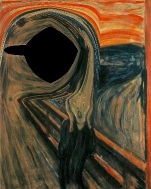
|
book reviews
Cosmology books |

|
book reviews
Cosmology books |
 his Fourth of July wouldn't it be great to lie back and read a book on all the exciting
stuff going on in astrophysics these days: tachyons, black holes, particle creation,
dark matter, Higgs bosons, and quantum gravity? No equations, just a nice, easy to read,
relaxing book to read while you're out in the sun getting irradiated.
his Fourth of July wouldn't it be great to lie back and read a book on all the exciting
stuff going on in astrophysics these days: tachyons, black holes, particle creation,
dark matter, Higgs bosons, and quantum gravity? No equations, just a nice, easy to read,
relaxing book to read while you're out in the sun getting irradiated.
Yeah, well ... this isn't it. Bambi and Dolgov say you have to understand the equations. What's more, to understand how the universe expanded to its present size you can't just look at general relativity. You also have to look at the smallest things in existence: subatomic particles.
The basics of GR and particle physics are reviewed in the first three chapters. Then the authors turn to the Standard Model of cosmology, starting with the basics: the Friedmann-Robertson-Walker metric, a little bit of thermodynamics. Finally in chapter 6 they get to the good stuff: inflation, baryogenesis, big bang nucleosynthesis, dark matter, and dark energy.

There is little hope, say Bambi and Dolgov, that we can understand dark energy until we understand basic things like particle masses. The quarks that make up a proton (p = uud) and neutron (n = udd) should have a total mass of 15 MeV minus the binding energy. Instead they're 62 times bigger: protons are 938.27 MeV and neutrons are 939.57 MeV. Where does all the extra mass come from?
The usual answer is that it comes from the energy of gluons, but there's more to it than that. Quantum chromodynamics (QCD) says it comes from the vacuum, which is not empty but filled with quark-gluon condensates, which have a negative vacuum energy of −1045 ρ0, where ρ0 is the present day energy density of the universe. The vacuum condensates, say the authors, are destroyed around quarks. For the mass of a proton to have its measured value, this subtraction has to happen with such precision that some unknown contribution to the vacuum energy must exist that balances it out with a precision of one part in 1045. [p.214]
This doesn't necessarily mean somebody set the values so they'd cancel out; it merely means there's a strict law of physics somewhere that makes it happen.
But it gets us to the crisis of the vacuum energy density. Vacuum energy density is a fundamental property of spacetime. Compared to empirical measurements, the predicted value in the standard model of particle physics is off by somewhere between 59 and 123 orders of magnitude (1091 g/cm3 vs 0.75×10−29 g/cm3).
When physicists get something wrong, they don't fool around.
“Cold” is not the first thing that comes to mind when we think about the big bang. But cosmologists are now saying that the universe started out small, cold, and empty. According to the standard cosmological model, matter and energy were not present at the instant of creation, but were the result of inflaton decay. Inflaton is a scalar field 𝜙 that most models utilize to reproduce the cosmic inflation.
They say that the universe's temperature in MeV is as a first approximation equal to the square root of its age in seconds. At the onset of the big bang nucleosynthesis epoch the plasma temperature was only around 1 MeV—downright chilly by cosmological standards—and the particles were relativistic.
In the course of the cosmological expansion, the energy density of the inflaton field, first very slowly when 𝜙 ≈ constant, and later, when 𝜙 begun to oscillate, the stored vacuum-like energy of 𝜙 turned into the energy of a hot ‘soup’ of elementary particles. At the first stage, the universe looked as a dark expanding empty place. The second stage was the big bang, when the primeval plasma was created .... The total mass/energy of matter inside the observed universe volume is by far larger than the initial mass/energy inside the microscopic volume from which the universe originated. [p.95]
In layman's terms, that means no matter or energy were present at the moment of creation. Matter and energy were created from this mysterious inflaton field during the period of inflation. Inflation, they say, was exponential, increasing by a factor of 2.718 every 10−31 seconds. This went on 1013 times. After inflation, the temperature was 5×1011 GeV or 3.221 ×1024 degrees Fahrenheit, which is terribly hot indeed.
Bambi says the universe started out cold. But cold might not be the best term for it. The preinflation universe was cold in much the same way that black holes are considered cold. The temperature of a black hole is inversely proportional to its size. The biggest ones are said to be just above absolute zero—not because they're really cold inside, but because they don't radiate. Of course if you stuck a thermometer in one, you'd get a different result. This is left as an exercise, but no extra credit for predicting that it would get broken.
An interesting side note is the role of magnetic monopoles. Dirac proposed their existence, and some theories predict that they had to be abundant in the early universe. However, the mass of a monopole would have to be about 1016 GeV, which is 24 orders of magnitude higher than is allowed by observation. If monopoles existed, and if they were this heavy, they would have over-closed the universe, the authors say, which means it would have gone into a big crunch by now.
The inflaton field created equal amounts of matter and antimatter (or as I prefer to call it, for reasons of symmetry, antimatter and unklymatter). So where is all the antimatter? This is the problem of baryon asymmetry. They discuss several theories. Maybe it is all sequestered in black holes. Maybe it somehow got converted to dark matter. Or maybe some charge-parity violation destroyed it. We don't know the answer.
You might ask whether any of this will ever be more than speculation, since we will never be able to verify most of this experimentally. In fact, the cosmic microwave background, which represents the redshifted light from the age of hydrogen recombination 370,000 years after the big bang, may give us some answers. And I suspect you'd change your mind pretty fast if fifty billion tons of that missing antimatter turned up behind the sofa while you were watching Zombie Sharks. It could happen.
The authors extensively cite their own work. Lots of equations and color graphs but no diagrams and no index. Not as expensive as some scientific books.
jul 04, 2016
 his book is the product of an eight year collaboration between a philosopher (R.M. Unger)
and a physicist (Lee Smolin). The benefits are readily apparent: each has gained a greater
appreciation of the other's terminology and viewpoint, to the benefit of their thinking
about cosmology.
his book is the product of an eight year collaboration between a philosopher (R.M. Unger)
and a physicist (Lee Smolin). The benefits are readily apparent: each has gained a greater
appreciation of the other's terminology and viewpoint, to the benefit of their thinking
about cosmology.
Even so, the contrast is stark: science is by nature positive and evidence driven, emphasizing what must be true, while philosophy emphasizes what cannot be true. The first 347 pages, written by Unger, feel almost entirely negative. There are no multiverses. String theory is bunk. Cosmologists can't say that the universe was created from nothingness, and they can't say it is eternal. This part is also more than twice as long as the physics section, despite the similarities in their arguments. Make of that what you will.
Both make three assertions:
Mathematics is only a tool, says Unger, not an infallible guide to reality. If it were, then physics would be little more than discovering which things in the real world correspond to various mathematical structures. He writes: “mathematics is smaller, not greater, than nature.” [p.18]
Many non-physicists would agree. Physics is a science based on modeling the universe through math. Thus the anthropic principle applies: if a phenomenon cannot be explained with math, physicists cannot study it. The “unreasonable effectiveness” of math may be partly or even mostly an illusion.
Unger says, in effect, that physics wrongly takes itself to be necessary while other sciences, such as biology and geology, are contingent. Cosmology's most significant discovery is that the universe has a history. The universe, he says, is awash with time. Therefore the laws of physics must also take time into account.
He suggests that, just as the four forces were once unified, in the early universe the laws of nature were unified with states of affairs; as it cooled they became distinguishable from them.
The ideas that everything changes - laws and even symmetries and supposed constants, that the stable and recurrent relations that our causal explanations ordinarily invoke cannot be constant or eternal but rather must co-evolve together with the states of affairs; that there may be causality with out laws ... may seem strange ...
Everything that exists ... takes place in time ... the laws of nature must in principle be susceptible to change.

This section is déjà vu inducing, but otherwise decently written. Lee Smolin's 162 pages are crisper and more to the point, but his thesis is the same: rules change. Little progress has been made in physics since the 1970s. As Doctor Daystrom from Star Trek would say, a whole new approach is needed.
That's the challenge for cosmologists: new physical laws are needed. But a law is a generalization from multiple instances, whereas we only have a single instance in cosmology. Thus, Smolin says, the Newtonian paradigm of universal laws can't be applied to cosmology.
Smolin says that time is fundamental but space is not. Therefore the physical constants and laws of physics must change over time. Smolin suggests, for example, that the inflaton could have evolved over time to become the Higgs boson. With his deep understanding of physics he even makes it seem plausible. He outlines his new approach, while recognizing the value of other theories—and he even seems to be warming up to string theory.
Smolin recognizes, of course, that evidence is what would be needed to convince people. String theory is underdetermined, both authors say, but without evidence their theory will suffer the same fate. Their hope is to inspire a bigger search for time-dependent changes in gravity, the fine structure constant, and maybe even particle masses.
Something for all those bored postdocs to do.
july 31, 2016